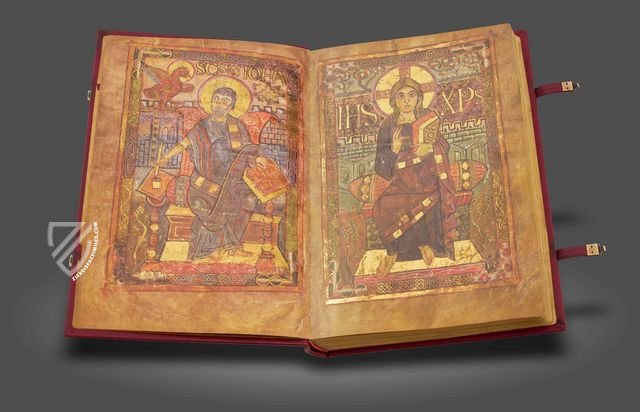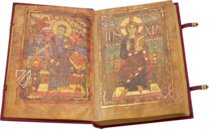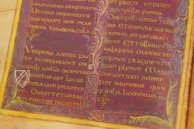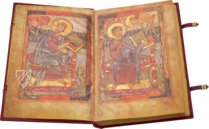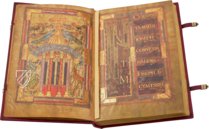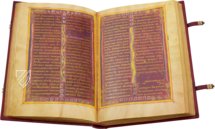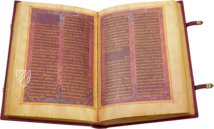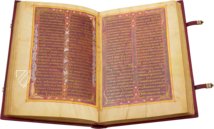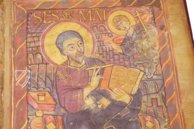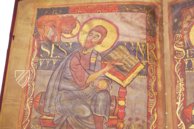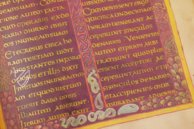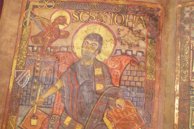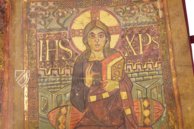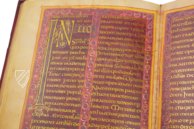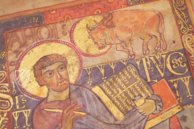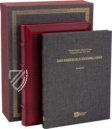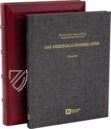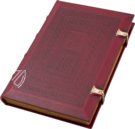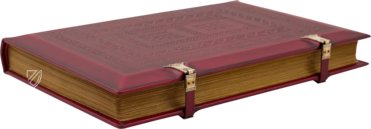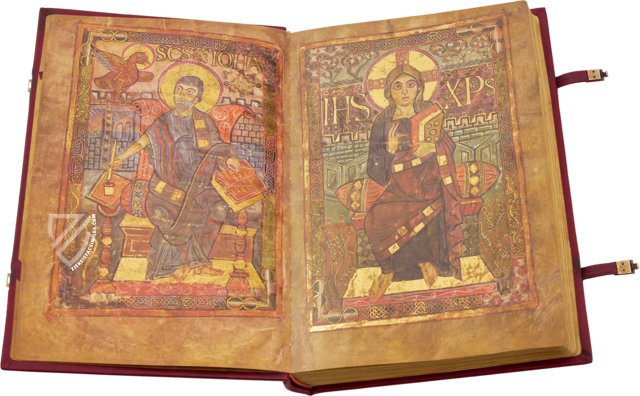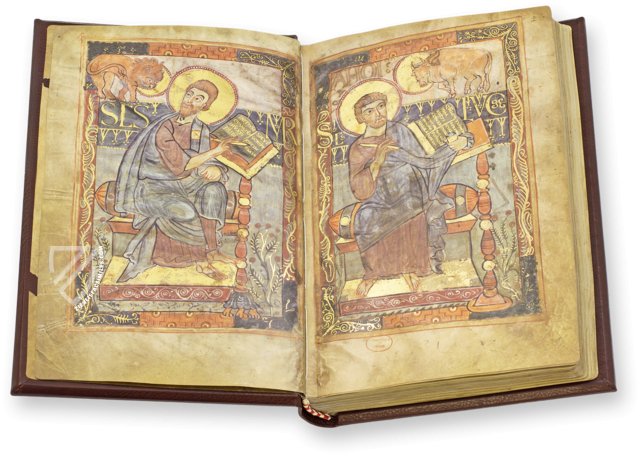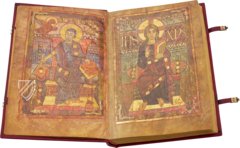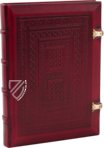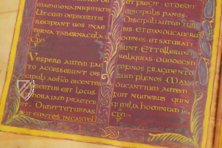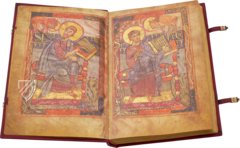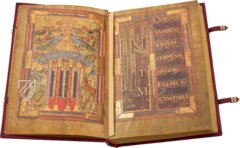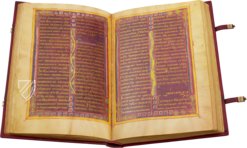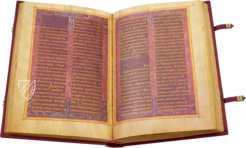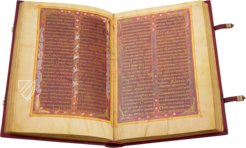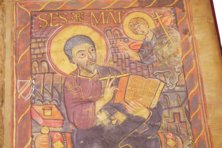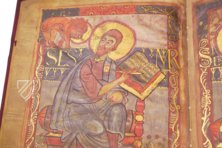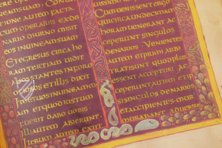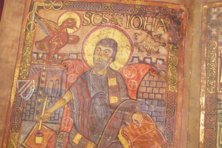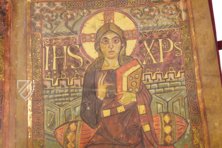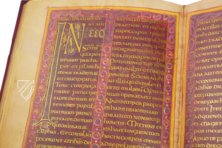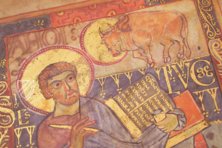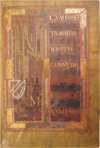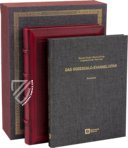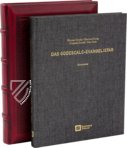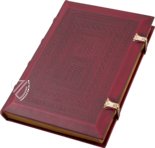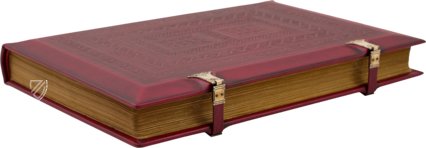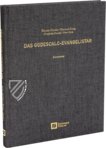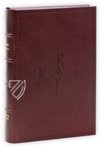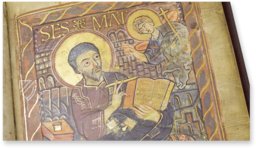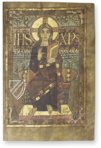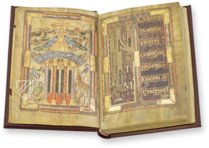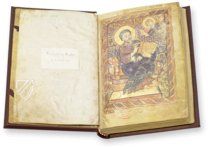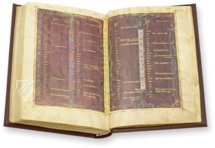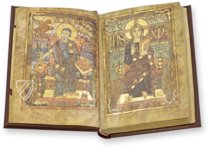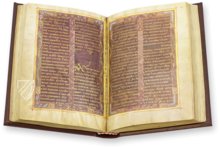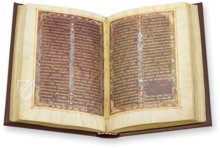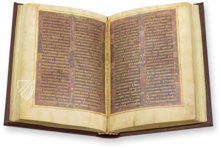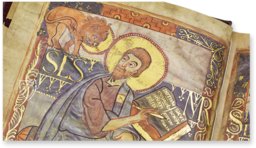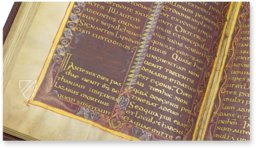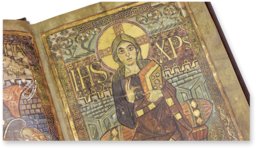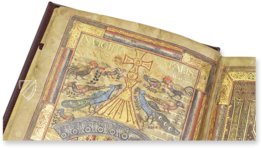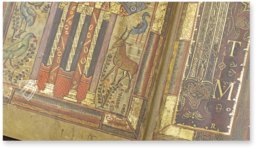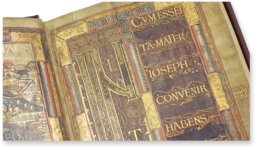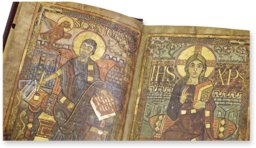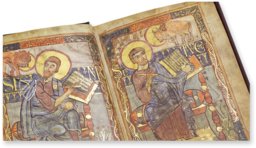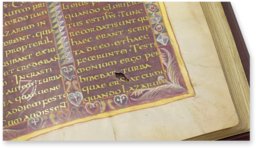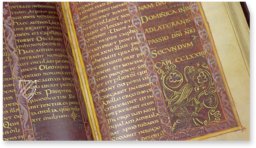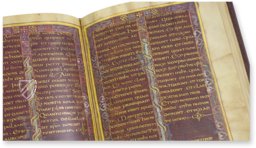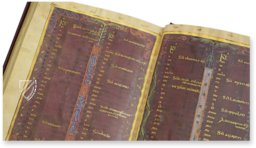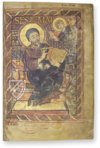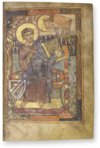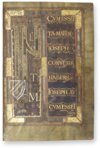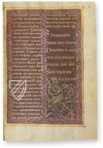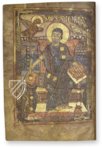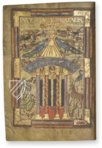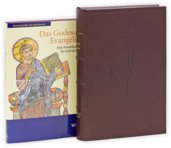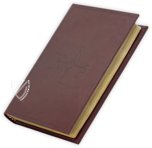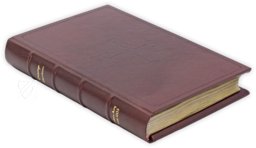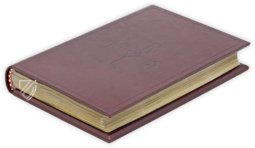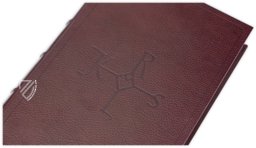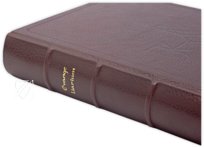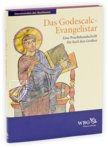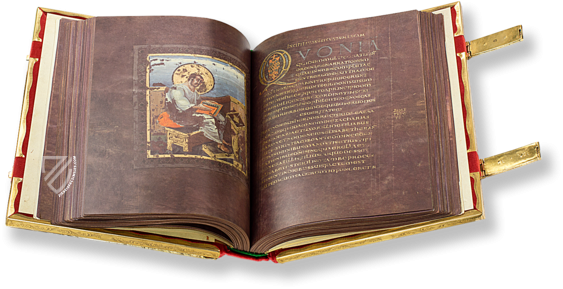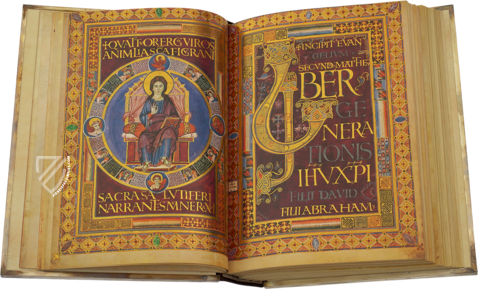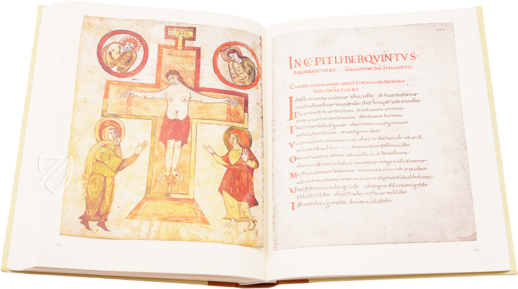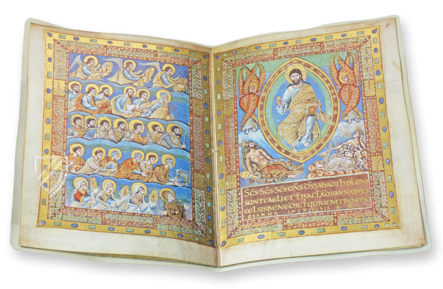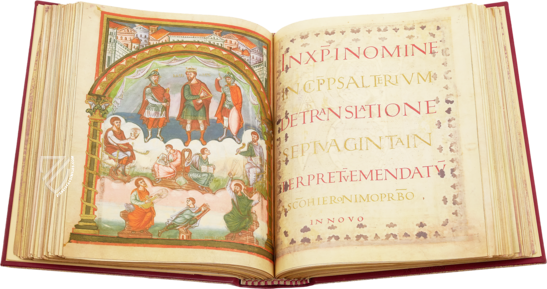Godescalc Evangelistary
(3,000€ - 7,000€)
Between 781 and 783, Charlemagne (747/8–814) personally commissioned the Godescalc Evangelistary together with his wife Hildegard (ca. 758–783) from the scriptorium of his Court School at Aachen. It came to be one of the most glorious manuscripts from the Carolingian period to survive today. The text of the Gospel readings is written in gold and silver ink on purple parchment and were accompanied by six full-page miniatures showing the four Evangelists, Christ, and a fountain of life. Glimmering initials and interesting ornamental borders additionally adorn the entire liturgical luxury manuscript. The easily recognizable transition between the Insular and antique-like illumination. Thus, one can find wave bands, acanthus ornaments and wickerwork patterns in the frames of the miniatures.
Godescalc Evangelistary
The Godescalc Evangelistary is one of the most beautiful and costly manuscripts from the Carolingian period to survive to the present. It was made at the behest of no less than Charlemagne (747/8–814) and his wife Hildegard (ca. 758–783) in the scriptorium of his Court School at Aachen between 781 and 783, and is furnished with particularly rich and noble materials. Stretching across 254 ages altogether, the text of the Gospel readings glimmers in precious gold and silver ink on purple parchment. The manuscript was introduced by six full-page miniatures showing the four Evangelists, Christ, and a fountain of life, while richly ornamented and sparkling initials accompany the entire text.
Noble Materials with Significance
A manuscript personally commissioned by Charlemagne is obviously going to be furnished with every art of painting and writing available at the time. Nevertheless, aside from its decorative purpose, the noble materials have a symbolic meaning: the splendid luminosity of gold, silver, and purple supposed to be reminiscent of the heavenly kingdom and eternal life.
First Class Miniatures Straight from Aachen
The luminous manuscript originated in the scriptorium of the Court School of Charlemagne in Aachen. Today, there are still eight complete manuscripts and a fragment originating from this scriptorium, of which the Godescalc Evangelistary is the oldest. The liturgical manuscript owes its name to the scribe Godescalc who accompanied Charlemagne on his journey to Italy.
Stylistic Variety of the Miniatures
The stylistic variety of the miniatures is extremely interesting to observe. One is able to find both Insular wickerwork patterns as well as antique-like wave bands and acanthus ornaments. This variety of motifs is appended by the already modeling use of color, which lends the figures and space more plasticity. This pursuit of a logical connection between the figures and the space in which they find themselves is style building for the subsequent works of the Aachen scriptorium.
Codicology
- Alternative Titles
- Godescalc Sacramentary
Godescalc Gospels
Godescalc Gospel Lectionary
Godescalc-Evangelistar
Évangéliaire de Godescalc ou de Charlemagne
Evangelistario di Godescalco - Size / Format
- 254 pages / 31.2 × 21.0 cm
- Origin
- Germany
- Date
- 781–783
- Epochs
- Style
- Language
- Script
- Carolingian minuscule Roman Rustic Capitals Roman uncial
- Illustrations
- 6 full-page miniatures: The four Evangelists, Christ in Majesty and the Fountain of Life. The hole text is written in gold and silver on purple parchment.
- Content
- Readings from the Gospels for the Mass; calendar; Easter tables; dedication poem
- Patron
- Charlemagne and his wife Hildegard
- Artist / School
- Godescalc (scribe)
- Previous Owners
- Napoléon I
Musée des Souverains
Godescalc Evangelistary
Incipit Page: Christmas Vigil
On the left, the huge gold leaf initials are a mesmerizing cosmos of interlace patterns. The neatly written text in the right column consists of alternating lines of gold and silver, the latter of which has tarnished black so that it is barely legible against the purple background, but would have shimmered brilliantly when it was made over 1,200 years ago. It is a phenomenal incipit page made with only the finest materials, even the backgrounds are dyed with incredibly expensive purple ink.
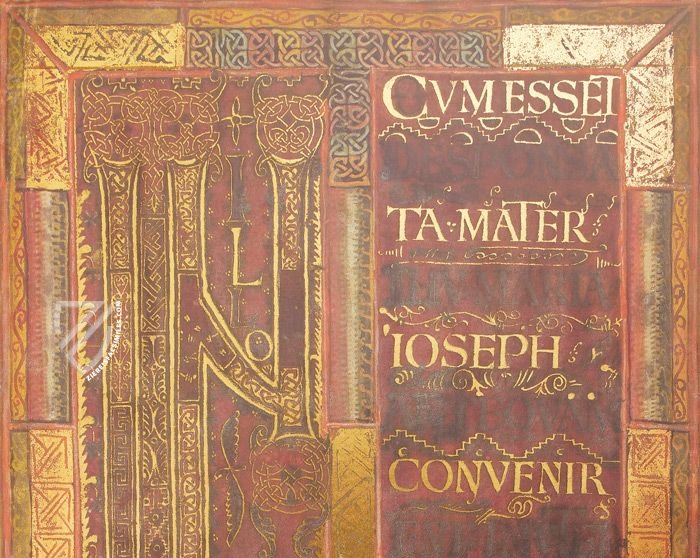
Godescalc Evangelistary
Portrait of John the Evangelist
This is simultaneously the earliest known Carolingian manuscript and one of the finest, as this Evangelist portrait can attest to. Only the richest materials – gold, silver, and purple parchment – were worthy of Charlemagne. John is given special status as his miniature is facing that of Christ in Majesty.
This sparkling composition is presented within a frame of Insular interlace. Holding a codex as he inks his stylus, John is depicted recording Christ’s life as a witness without adding his own creativity. John is seated on a throne – an allusion to Charlemagne’s authority over Rome, which he had recently saved from the Lombards, conquering them in 774 to claim the Iron Crown of Italy, an event commemorated by this commission.
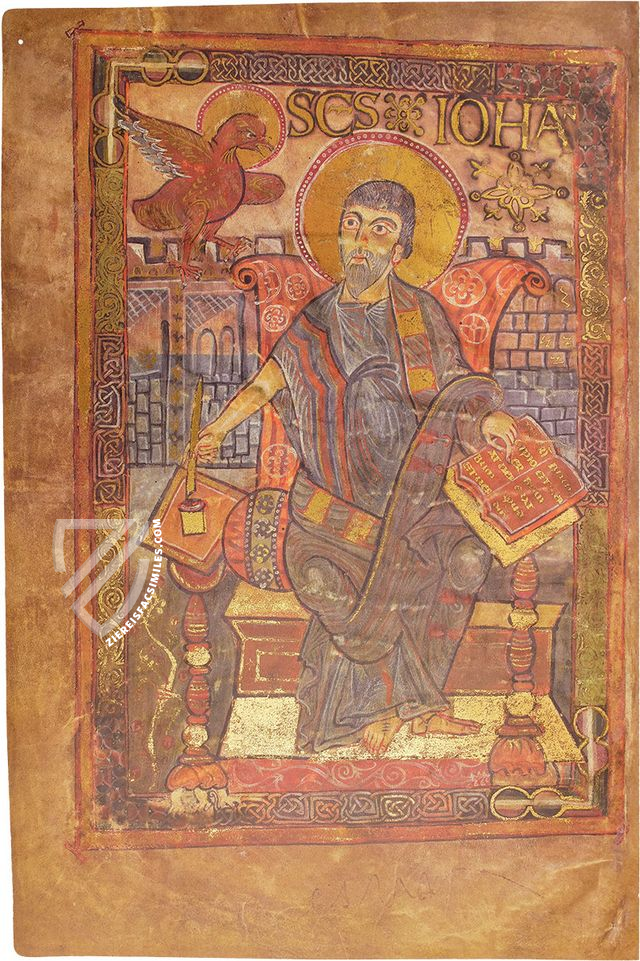
#1 Godescalc Evangelistar
Language: German
(3,000€ - 7,000€)
#2 Godescalc Evangelistary - library edition
Language: German
(3,000€ - 7,000€)
- Treatises / Secular Books
- Apocalypses / Beatus
- Astronomy / Astrology
- Bestiaries
- Bibles / Gospels
- Chronicles / History / Law
- Geography / Maps
- Saints' Lives
- Islam / Oriental
- Judaism / Hebrew
- Single Leaf Collections
- Leonardo da Vinci
- Literature / Poetry
- Liturgical Manuscripts
- Medicine / Botany / Alchemy
- Music
- Mythology / Prophecies
- Psalters
- Other Religious Books
- Games / Hunting
- Private Devotion Books
- Other Genres
- Afghanistan
- Armenia
- Austria
- Belgium
- Belize
- Bosnia and Herzegovina
- China
- Colombia
- Costa Rica
- Croatia
- Cyprus
- Czech Republic
- Denmark
- Egypt
- El Salvador
- Ethiopia
- France
- Germany
- Greece
- Guatemala
- Honduras
- Hungary
- India
- Iran
- Iraq
- Israel
- Italy
- Japan
- Jordan
- Kazakhstan
- Kyrgyzstan
- Lebanon
- Liechtenstein
- Luxembourg
- Mexico
- Morocco
- Netherlands
- Palestine
- Panama
- Peru
- Poland
- Portugal
- Romania
- Russia
- Serbia
- Spain
- Sri Lanka
- Sweden
- Switzerland
- Syria
- Tajikistan
- Turkey
- Turkmenistan
- Ukraine
- United Kingdom
- United States
- Uzbekistan
- Vatican City
- A. Oosthoek, van Holkema & Warendorf
- Aboca Museum
- Ajuntament de Valencia
- Akademie Verlag
- Akademische Druck- u. Verlagsanstalt (ADEVA)
- Aldo Ausilio Editore - Bottega d’Erasmo
- Alecto Historical Editions
- Alkuin Verlag
- Almqvist & Wiksell
- Amilcare Pizzi
- Andreas & Andreas Verlagsbuchhandlung
- Archa 90
- Archiv Verlag
- Archivi Edizioni
- Arnold Verlag
- ARS
- Ars Magna
- ArtCodex
- AyN Ediciones
- Azimuth Editions
- Badenia Verlag
- Bärenreiter-Verlag
- Belser Verlag
- Belser Verlag / WK Wertkontor
- Benziger Verlag
- Bernardinum Wydawnictwo
- BiblioGemma
- Biblioteca Apostolica Vaticana (Vaticanstadt, Vaticanstadt)
- Bibliotheca Palatina Faksimile Verlag
- Bibliotheca Rara
- Boydell & Brewer
- Bramante Edizioni
- Bredius Genootschap
- Brepols Publishers
- British Library
- C. Weckesser
- Caixa Catalunya
- Canesi
- CAPSA, Ars Scriptoria
- Caratzas Brothers, Publishers
- Carus Verlag
- Casamassima Libri
- Centrum Cartographie Verlag GmbH
- Chavane Verlag
- Christian Brandstätter Verlag
- Circulo Cientifico
- Club Bibliófilo Versol
- Club du Livre
- CM Editores
- Collegium Graphicum
- Collezione Apocrifa Da Vinci
- Comissão Nacional para as Comemorações dos Descobrimentos Portugueses
- Coron Verlag
- Corvina
- CTHS
- D. S. Brewer
- Damon
- De Agostini/UTET
- De Nederlandsche Boekhandel
- De Schutter
- Deuschle & Stemmle
- Deutscher Verlag für Kunstwissenschaft
- DIAMM
- Droz
- E. Schreiber Graphische Kunstanstalten
- Ediciones Boreal
- Ediciones Grial
- Ediclube
- Edições Inapa
- Edilan
- Editalia
- Edition Deuschle
- Edition Georg Popp
- Edition Leipzig
- Edition Libri Illustri
- Editiones Reales Sitios S. L.
- Éditions de l'Oiseau Lyre
- Editions Medicina Rara
- Editorial Casariego
- Editorial Mintzoa
- Editrice Antenore
- Editrice Velar
- Edizioni Edison
- Egeria, S.L.
- Eikon Editores
- Electa
- Emery Walker Limited
- Enciclopèdia Catalana
- Eos-Verlag
- Ephesus Publishing
- Ernst Battenberg
- Eugrammia Press
- Extraordinary Editions
- Fackelverlag
- Facsimila Art & Edition
- Facsimile Editions Ltd.
- Facsimilia Art & Edition Ebert KG
- Faksimile Verlag
- Feuermann Verlag
- Folger Shakespeare Library
- Franco Cosimo Panini Editore
- Friedrich Wittig Verlag
- Fundación Hullera Vasco-Leonesa
- G. Braziller
- Gabriele Mazzotta Editore
- Gebr. Mann Verlag
- Gesellschaft für graphische Industrie
- Getty Research Institute
- Giovanni Domenico de Rossi
- Giunti Editore
- Graffiti
- Grafica European Center of Fine Arts
- Guido Pressler
- Guillermo Blazquez
- Gustav Kiepenheuer
- H. N. Abrams
- Harrassowitz
- Harvard University Press
- Helikon
- Hendrickson Publishers
- Henning Oppermann
- Herder Verlag
- Hes & De Graaf Publishers
- Hoepli
- Holbein-Verlag
- Houghton Library
- Hugo Schmidt Verlag
- Idion Verlag
- Il Bulino, edizioni d'arte
- ILte
- Imago
- Insel Verlag
- Insel-Verlag Anton Kippenberger
- Instituto de Estudios Altoaragoneses
- Instituto Nacional de Antropología e Historia
- Introligatornia Budnik Jerzy
- Istituto dell'Enciclopedia Italiana - Treccani
- Istituto Ellenico di Studi Bizantini e Postbizantini
- Istituto Geografico De Agostini
- Istituto Poligrafico e Zecca dello Stato
- Italarte Art Establishments
- Jan Thorbecke Verlag
- Johnson Reprint Corporation
- Josef Stocker
- Josef Stocker-Schmid
- Jugoslavija
- Karl W. Hiersemann
- Kasper Straube
- Kaydeda Ediciones
- Kindler Verlag / Coron Verlag
- Kodansha International Ltd.
- Konrad Kölbl Verlag
- Kurt Wolff Verlag
- La Liberia dello Stato
- La Linea Editrice
- La Meta Editore
- Lambert Schneider
- Landeskreditbank Baden-Württemberg
- Leo S. Olschki
- Les Incunables
- Liber Artis
- Library of Congress
- Libreria Musicale Italiana
- Lichtdruck
- Lito Immagine Editore
- Lumen Artis
- Lund Humphries
- M. Moleiro Editor
- Maison des Sciences de l'homme et de la société de Poitiers
- Manuscriptum
- Martinus Nijhoff
- Maruzen-Yushodo Co. Ltd.
- MASA
- Massada Publishers
- McGraw-Hill
- Metropolitan Museum of Art
- Militos
- Millennium Liber
- Müller & Schindler
- Nahar - Stavit
- Nahar and Steimatzky
- National Library of Wales
- Neri Pozza
- Nova Charta
- Oceanum Verlag
- Odeon
- Orbis Mediaevalis
- Orbis Pictus
- Österreichische Staatsdruckerei
- Oxford University Press
- Pageant Books
- Parzellers Buchverlag
- Patrimonio Ediciones
- Pattloch Verlag
- PIAF
- Pieper Verlag
- Plon-Nourrit et cie
- Poligrafiche Bolis
- Presses Universitaires de Strasbourg
- Prestel Verlag
- Princeton University Press
- Prisma Verlag
- Priuli & Verlucca, editori
- Pro Sport Verlag
- Propyläen Verlag
- Pytheas Books
- Quaternio Verlag Luzern
- Reales Sitios
- Recht-Verlag
- Reichert Verlag
- Reichsdruckerei
- Reprint Verlag
- Riehn & Reusch
- Roberto Vattori Editore
- Rosenkilde and Bagger
- Roxburghe Club
- Salerno Editrice
- Saltellus Press
- Sandoz
- Sarajevo Svjetlost
- Schöck ArtPrint Kft.
- Schulsinger Brothers
- Scolar Press
- Scrinium
- Scripta Maneant
- Scriptorium
- Shazar
- Siloé, arte y bibliofilia
- SISMEL - Edizioni del Galluzzo
- Sociedad Mexicana de Antropología
- Société des Bibliophiles & Iconophiles de Belgique
- Soncin Publishing
- Sorli Ediciones
- Stainer and Bell
- Studer
- Styria Verlag
- Sumptibus Pragopress
- Szegedi Tudomànyegyetem
- Taberna Libraria
- Tarshish Books
- Taschen
- Tempus Libri
- Testimonio Compañía Editorial
- Thames and Hudson
- The Clear Vue Publishing Partnership Limited
- The Facsimile Codex
- The Folio Society
- The Marquess of Normanby
- The Richard III and Yorkist History Trust
- Tip.Le.Co
- TouchArt
- TREC Publishing House
- TRI Publishing Co.
- Trident Editore
- Tuliba Collection
- Typis Regiae Officinae Polygraphicae
- Union Verlag Berlin
- Universidad de Granada
- University of California Press
- University of Chicago Press
- Urs Graf
- Vallecchi
- Van Wijnen
- VCH, Acta Humaniora
- VDI Verlag
- VEB Deutscher Verlag für Musik
- Verlag Anton Pustet / Andreas Verlag
- Verlag Bibliophile Drucke Josef Stocker
- Verlag der Münchner Drucke
- Verlag für Regionalgeschichte
- Verlag Styria
- Vicent Garcia Editores
- W. Turnowski Ltd.
- W. Turnowsky
- Waanders Printers
- Wiener Mechitharisten-Congregation (Wien, Österreich)
- Wissenschaftliche Buchgesellschaft
- Wissenschaftliche Verlagsgesellschaft
- Wydawnictwo Dolnoslaskie
- Xuntanza Editorial
- Zakład Narodowy
- Zollikofer AG

